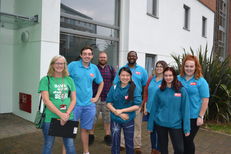Bringing the spotlight away from the big bling projects, to the glamorous world of toilets and urinals at UWE. In the world’s largest living lab, a combined effort from academics, operational staff, industry experts, and students, has identified initial savings of over £145k can be made in wasted water at UWE alone, largely from being flushed down 2,000 toilets with faulty flushes! This thrill-seeking investigative spirit has spilled over into identifying LOOsing more water down urinals around campus!
This is the largest academic/operational collaboration at UWE, using research and data analysis to inform actions across site, with remarkable results. It’s not a project to photograph, but what is stunning are the savings - already at £20,000 after a few months’ focus, with £145k annual savings to be realised with retrofitting taking place May – July 2018, with further projects being identified continuously.
Top 3 learnings:
1. Making time and space for collaborative working brings insights that cannot be achieved alone.
2. Good, reliable data to inform actions, and ensure immediate savings are made has been invaluable.
3. Big savings can be made from small volumes of water being wasted continuously!
CO2t savings 2017/2018: 7.3 to date – actual measurable (more not measurable due to metering restrictions)
CO2t savings 2018/2019: 54 (Estimated)
CO2t savings over the life cycle of the project: 1350 (Estimated over 25 years)







 Except where otherwise stated, content on this site is
licensed under a Creative Commons Attribution 3.0 License.
Except where otherwise stated, content on this site is
licensed under a Creative Commons Attribution 3.0 License.
